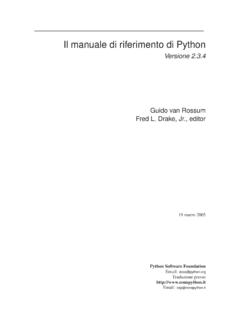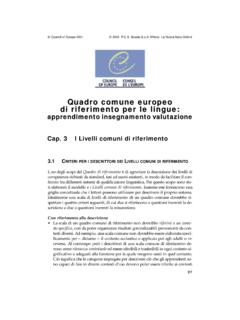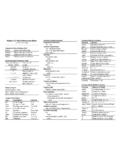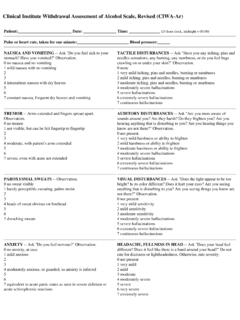Transcription of Hydraulic Scre-in Cartridge alves (SiC) - Eaton
1 Hydraulic Screw-in Cartridge Valves (SiCV)Technical referenceHIC manifold design guidelines, tooling, torque specifications, port and cavity dimensionsM-3 Eaton Hydraulic Screw-in Cartridge Valves (SiCV) E-VLSC-MC001-E6 January 2018 referenceGENERAL GUIDELINES FOR Hydraulic INTEGRATED CIRCUITS (HIC) ..M-4 PREFERRED TOOLING FOR MACHINING OF CUSTOM MANIFOLDS ..M-7 PREFERRED TOOLING FOR MACHINING CUSTOM MANIFOLDS ..M-8 TORQUE SPECIFICATIONS ..M-9 PORT TOOLS ..M-12C ** 2(P) ..M-14C-**-2 CAVITY DIMENSIONS ..M-15C-**-3 CAVITY DIMENSIONS ..M-16C-**-3S CAVITY DIMENSIONS ..M-17C-**-4 CAVITY DIMENSIONS ..M-18C-**-4U CAVITY DIMENSIONS ..M-19C-**-5S CAVITYDIMENSIONS ..M-20 Cartridge CAVITIES ..M-21TC CAVITY ..M-34M-4 Eaton Hydraulic Screw-in Cartridge Valves (SiCV) E-VLSC-MC001-E6 January 2018 measurements are critical request certified drawings. We reserve the right to change specifications without circuitAll designs begin with a schematic circuit design inspired by the application.
2 Before the planning stage, review the design utilizing the following steps: Match schematic symbolsto model codes. Note size and cavity ofeach valve and write it onschematic. Note port numbers of thevalves and write them onschematic. Note manifold port typesand sizes specified bycustomer. Note pressure, flow andmaterial of manifold block(steel or aluminum).Circuit questions should be answered by the customer before beginning a design. It is also recommended that schematic Hydraulic regions or networks be color coded using color pens. Regions or networks may be broken down in individual colors (pressure, tank, pilot, etc.) but it may be easier to design if regions are broken down into sub-regions such as pressure from port one of a solenoid valve to port two of a relief valve. Colored layers may be assigned later to match schematic circuit designOnce the circuit is fully understood, it is advisable to lay the design out by hand first.
3 Things to consider while planning the design are: Block size is often specifiedby customer. Specify an overallenvelope size, in additionto the specified blocksize. Overall envelope sizeincludes block size and anyvalves or fittings protrudingfrom the manifold block. Restrictions specified fora mounting surface of themanifold block. Valves andports may be restrictedfrom a particular surface. Specify mounting holes,threaded holes and thruholes (if necessary). Arrange valves in a logicalmanner. Valves and ports in the same regions should be located in close proximity to each other. Eliminate as many turns inthe regions as possible toreduce the number of crossdrill holes or constructionlines. This helps keeppressure drops ( DP) andmanufacturing costs sizesTo obtain an optimal cost manifold it is desirable to select a standard material size for the manifold, compare the block size with the standard material size table.
4 See Standard Material Sizes (page M-5). If a standard size is notavailable, a cut plate may schematicIf a schematic is desired on the assembly, it may be created from existing symbols. As an alternative, the entire circuit may be created outside of an assembly and imported as a symbol (block). All of the Vickers screw-in Cartridge valves have schematic symbols which can be found in the SICV Cartridge Valve Library of Symbols CD, used in conjunction with AutoCad software. Schematic symbols not found in the library may be created on an as needed designAll dimensions on CAD design must be accurate and to scale in order to be utilized by CAM software in conjunction with CNC machine tools. Manually or interactively modified dimension cannot be :NFailure to ensure that CAD dimensions are accurate and to scale may result in improper machinery by CNC Machine pNintThe datum point or origin point (0,0,0) on machining drawings is the upper left corner when facing the front dimensiNningDimension all ports, mounting holes and overall envelope clearancesAllow enough room for clearance around solenoid coils, handknobs, levers and wrench clearance for fittings.
5 If 90 elbow fittings are to be used, some may be required to swing a full 360 nNtesNotes are added for standard or special assembly, handling, or shipping instructions, as well as special tableInclude a port table with names and sizes of all tNNlingIn order to obtain fast turnaround on designs, limit the tooling used to that listed in the standard tooling table. See Preferred Tooling for Machining Manifolds (page M- 6).General guidelines for Hydraulic integrated circuits (HIC) WarningThis information is designed to assist the engineering professional in the design of manifold blocks and related Hydraulic systems. It is the designer s responsibility to verify the adequacy of the design through approporate verifications, review and testing of the final Hydraulic Screw-in Cartridge Valves (SiCV) E-VLSC-MC001-E6 January 2018 measurements are critical request certified drawings.
6 We reserve the right to change specifications without up the blNckAlways square up the raw block before machining the cavities, ports and holes. This is to eliminate any potential drill walk which leads to scrapped manifolds. When squaring up a block, remove approximately of material from each face for Aluminum blocks and of material from each face for steel blocks. This is done to ensure that all six faces are parallel or perpendicular. Finished machining should reflect the squared up dimensions. See Standard Material Sizes (Table 1).Example: x x ( mm x 127 mm x mm) block will be dimensioned to x x ( mm x mm x mm).CreatiNn Nf machining tableCreate a machining operation table or bore chart. Machining depths are given from the surface of the block. List all drill depths, mills, taps and form tools in the machining table.
7 Call out drill depths at the shoulder depth of the drill, not to the drill point depthsAll machining depths are to the corner of the full diameter as opposed to the drill point. All depths are measured from the face plane (surface) of a manifold any drill depths greater than 25 diameters. Additional line lengths may result in increasing pressure nNtesMachining notes are to be added for standard or special machining, handling and shipping that go completely through a cavity port area should be on the center axis of the cavity wherever possible; see Figure (a). Otherwise it should intersect the cavity tangent to the outside diameter of the bore it connects with; see Figure (b).NNtee: Breaking into a cavity at some point in between these recommended areas will lead to drill walk and can result in a high scrap rate, as well as premature drill depthsAll SAE ports and cavities have spotface depths of.
8 031 (.8 mm) unless otherwise specified. BSPP ports have spotface depths of .060 ( mm) unless otherwise counterbore cases, the actual cavity spotface is located at the depth of the counterbore. When counterbore depths are greater than , the following diameters should be used:Use Nf expander plugs and zerN leak gNld sae N-ring plugsOn small HIC packages, expander plugs can be used to block off construction drilling at the surface of a face. Larger than a 12mm expander plug are not recommended in aluminum. Any construction drillings larger than (10 mm) are plugged with zero leakgold SAE O-Ring plugs (internalhex type). The machiningcallout for these plugs can beeither the industry standardSAE straight thread O-ringboss port configuration or thestraight thread O-ring bossshort port configuration. Referto Port Dimensions (page M-9and M -10).Surface treatmentsAny manifold face that calls for a surface mounted (gasket mounted) valve such as a DG4V type directional control valve, or a pump or motor interface, should have a minimum roughness callout of 63 microinches (.)
9 0016mm) and a flatness callout of .002 (.05mm). See examples prevent corrosion, steel manifolds are oil dipped or coated with rust protective fluid, unless otherwise specified. To prevent oxidation, aluminum manifold blocks are gold anodize, unless otherwise specified. Aluminum manifolds where the internally grounded coil is used should not be anodized. Prototypes are supplied without surface treatment.(a) (b) Datum Point Example in orthographic third angle guidelines for Hydraulic integrated circuits (HIC)Valve SeriesCounterboreInch Metric (mm) 35, 35, 44, 50, 65,0M-6 Eaton Hydraulic Screw-in Cartridge Valves (SiCV) E-VLSC-MC001-E6 January 2018 measurements are critical request certified drawings. We reserve the right to change specifications without thicknessFor pressures up to 3000 psi (210 bar), aluminum may be used, for pressures above 3000 PSI (210 bar).
10 Dura-Bar cast iron manifold material is cavities or bores require a greater wall thickness. The table below shows recommended minimum wall thicknesses for Aluminum and Dura-Bar. Life cycle Nf manifNld bl NcksBe aware that designing to these general guidelines will not guarantee the manifold will survive any finite number of cycles. The only way to properly assure a specified life is to run a thorough testing of both burst and endurance in the actual application 1 Standard material sizesGeneral guidelines for Hydraulic integrated circuits (HIC)Creating bill Nf material BOMD evelop a BOM that includes quantity, model codes, part numbers and descriptions of the HIC. Model codes of some valves require pressure settings. A machining operation table or bore chart should be created. All plugs, orifice plugs, disks, check valves, pistons, and any other part should be included in the BOM.

















